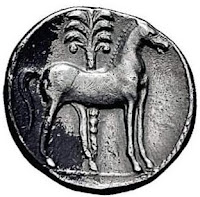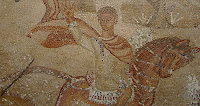Salve,
let us stay with the coins of the
Classical Antiquity and turn to the subject of the Numidian/Libyan
horse in the Greek and Roman world for this horse was one of the most famous horse of the Graeco-Roman world .
Libyan horse from a Carthaginian coin:
Various Numidian rulers included horses
on their coins
Diodorus Siculus,
in his Bibliotheca Historica, book XVII (from penelope.uchicago.edu or LacusCurtius), wrote about Alexander, the hero-king of Macedon and
soon Persia:
''Having settled the affairs of Egypt,
Alexander went off to the Temple of Ammon, where he wished to consult
the oracle of the god. When he had advanced half way along the coast,
he was met by envoys from the people of Cyrenê who brought him a
crown and magnificent figures, among which were three hundred
[war] chargers and five handsome four-horse chariots. He received the
envoys cordially and made a treaty of friendship and alliance with
them''
William Ridgeway wrote, quoting various ancient writers, in his book on The origin and influence of the Thoroughbred horse", page 253 :
''The islanders from Thera, who planted Cyrene, were not slow in fulfilling the prophecy of Medea that " instead of short- finned dolphins they should take to themselves fleet mares, and reins instead of oars should they ply, and speed the whirlwind- footed car," for Cyrene soon became famous as "the city of fair steeds and goodly chariots." Pindar glorified her king, Arcesilas, for his victories in the chariot-race, and later her native poet, Callimachus, sang of his " home famed for her steeds
Numidians on the Trajan Column:
..
Horse from a Roman Mosaic (present Tunisia)
..
Strabo, in ''Geography'' book XVII,
wrote on Numidian/Libyan Horse and the various tribes that rode or
used horses in Numidia/Lubia (From LacusCurtius):
''Although the most of the country inhabited by the Maurusians is so
fertile, yet even to this time most of the people persist in living a
nomadic life. But nevertheless they beautify their appearance by
braiding their hair, growing beards, wearing golden ornaments, and
also by cleaning their teeth and paring their nails. And only rarely
can you see them touch one another in walking, for fear that the
adornment of their hair may not remain intact. Their horsemen any
mostly with a javelin, using bridles made of rush, and riding
bareback; but they also carry daggers. The foot-soldiers hold before
them as shields the skins of elephants, and clothe themselves with
the skins of lions, leopards, and bears, and sleep in them. I might
almost say that these people, and the Masaesylians, who live next
after them, and the Libyans in general, dress alike and are similar
in all other respects, using horses that are small but swift, and so
ready to obey that they are governed with a small rod. The horses
wear collars made of wood [tree wool, perhaps cotton] or of hair, to which the rein is fastened,
though some follow even without being led, like dogs. These people
have small shields made of raw-hide, small spears with broad heads,
wear ungirded tunics with wide borders, and, as I have said, use
skins as mantles and shields. The Pharusians and Nigretes who live
above these people near the western Aethiopians also use bows, like
the Aethiopians; and they also use scythe-bearing chariots. The
Pharusians mingle only rarely even with the Maurusians when passing
through the desert since they carry skins of water fastened beneath
the bellies of their horses...'
Horses and riders from Roman mosaic from Libya
.
*
Roman writer of III century A.D. From
Carthago, Nemesianus (again from LacusCurtius ), wrote a poem on
hunting (Cynegetica) where he described, amongst others, the
Numidian/Libyan horses :
''..you may select the
courser sent by Mauretania (if he be a stout descendant of good
stock), or the horse which the dusky Mazax tribesman[Numidian] has
reared in desert fields and taught to undergo ceaseless toil. No need
to repine at their ugly head and ill-shapen belly, or at their lack
of bridles, or because both breeds have the temper of freedom, or
because the neck lashes the sloping shoulders with its mane. For he
is an easy horse to guide, plies obediently under the control of a
limber switch: its strokes are the orders for speed, its strokes are
as bridles too. Nay, once launched across the spacious levels of the
plain, with blood stirred, the steeds win fresh strength in the race,
leaving by degrees their eager comrades behind. Even so, on the
outburst of the winds across the blue waters of Nereus, when Thracian
Boreas has uprisen o'er his cavern and with shrill howling dismayed
the dreary waves, all the blasts on the troubled deep give way to
him: himself aglow mid foaming din, above the billows he o'ertops
them in mastery manifest upon the sea: the whole band of the Nereids
is mazed in wonderment as he passes over their watery domains.Nemesianus gives quite detailed description of the preparation of a hunting horse, with some remarks on their long lasting vigour and longevity if properly cared for :
''These horses are slow to attain confidence in prolonged running; also, theirs is youthful vigour even in age that has served its time. For no quality which has bloomed full at its due period suffers collapse in spirit ere physical powers fail. In the fresh spring-time, then, feed the coursers on soft mash, and, lancing a vein, watch old-standing ailments flow out with the ooze of the tainted blood. Soon strength returns joyously to their gallant hearts, moulding the sleek limbs with strength diffused: soon a better blood runs warm in their veins, and they wish for long stretches of road, and to make the broad plain vanish in their career. Next, when summer has hardened the ripening stalks and, scorching the juicy blades, has dried all the moisture for harvest and joined corn-ears [caveat! -not American Maize] to stems, then be sure to furnish barley and light chaff: moreover, there must be care to winnow the produce free from dust, and to run the hands over the horses' muscles, so that the courser may enjoy being patted and relax his body in pleasure and quickly pass the nourishing juices throughout his frame.''
*
another Roman writer Claudius Aelianus aka Aelian wrote, in Natura Animalium, about the Numidian/Libyan Horse :
''De equo Libyco Libyas talia narrare audio: Eos quidem equorum
velocissimos esse, nullo vero laboris sensu affici; graciles quoque nec
corpulentos, et idoneos ad sustinendam negligentiam dominorum; qui
nullam curam iis adhibent, neque eos, postquam labore fatigati fuerint,
strigile perfricant, nec eis volutabra conficiunt, nec ungulas purgant, nec jubam pectunt, nec capronas implicant, neque fessos lavant;
sed simulatque constitutum iter confecerint, ex equis desilientes
eosdem ad pastiones dimittunt. Ipsi Libyes etiam graciles sunt, et
squalore sordidi hujuscemodi equis etiam vehuntur. Medi autem luxuriae
dediti sunt, atque ejuscemodi illorum equi; quos magnitudine, specie
corporis, et ornatu, ac exteriore cultu atque deliciis una cum dominis
delectari diceres; sentire videntur magnitudinem et pulchritudinem suam itemque se magnifice esse exornatos.'' (translated from Greek to Latin on LacusCurtius).
*
Finally, the Numidan prince is the subject of the famous Bande
Dessinée (French-Belgian comics) series titled 'Jugurtha,'
with awesome horse drawings by two great, but unfortunately deceased,
artists Moebius and Franz Drappier
*
ps most images are from wikipedia

















3 comments:
Good work.
Telamon, thanks :)
This has been a great resource for my work regarding Horse and Bull linguistics and symbology being interchanged and confused. Thank you i hope you do not mind me using some quotes and imagery from your research in my own. If you are interested, you can follow my work at https://www.facebook.com/groups/335973217782011. Many Thanks again
Post a Comment